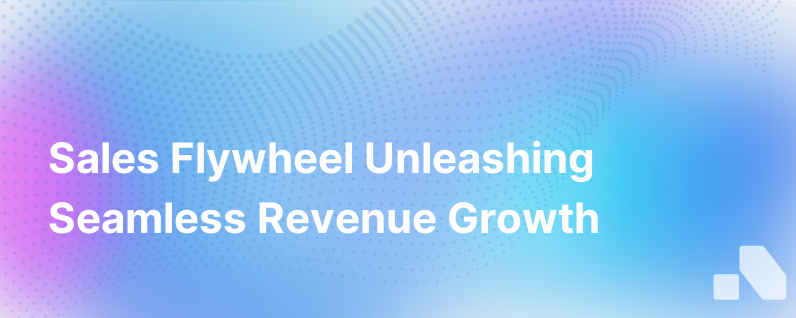
In today’s dynamic business climate, the traditional funnel model for sales and marketing is often criticized for being too linear and shortsighted, particularly in B2B contexts. Enter the sales flywheel — a vibrant, holistic framework that fosters sustained growth through the creation and leveraging of momentum.
The sales flywheel is not just a redux of the age-old sales process dressed in modern jargon. It's a model that reflects the interconnected and cyclical nature of customer interactions. At its core, the sales flywheel focuses on using the momentum of customer satisfaction to drive referrals and repeat sales, thus creating a self-sustaining engine of growth.
Understanding the Sales Flywheel
At its most fundamental, the flywheel concept represents a virtuous cycle — it’s about applying force in the right places, reducing friction wherever possible, and capturing and storing the rotational energy generated to keep your sales strategy spinning effectively.
Jeff Bezos, CEO of Amazon, is famously linked to the popularization of the concept of the flywheel in business. He visualized Amazon’s business as a flywheel, where lower prices lead to more customer visits, which attract more third-party sellers, leading to a broader selection, which improves efficiency and customer experience, ultimately looping back around to attract more visits.
For B2B companies, the sales flywheel emphasizes the nurturing of customer relationships long after an initial purchase to catalyze continued business growth. The stages break down somewhat differently than the funnel's discrete steps of Awareness, Consideration, and Decision.
Instead, the flywheel includes:
- Attracting potential customers
- Engaging them with valuable content and insights
- Delighting them with exceptional service and solutions
- Inspiring them to become advocates for your brand
Each of the stages within the flywheel lends energy to the next, keeping the overall cycle spinning and gaining speed.
Implementing the Sales Flywheel in B2B Contexts
The often complex and longer sales cycles in B2B markets demand careful attention to nurturing and retention, making the flywheel an especially apt model. Here's an expansive look at how B2B companies can set their flywheels into motion and maintain its inertia:
1. Attract: Instead of interrupting customers with disparate marketing tactics, attracting them involves creating content that aligns with their interests and challenges. Engaging platforms, thought leadership, SEO, social media, and events all play a role. Content here is not meant to sell but to inform and educate, establishing credibility and planting seeds for relationships.
2. Engage: Engaging is about building on that initial interest. Sales and marketing alignment is crucial in this stage. Personalized follow-up communications, consultative selling, and responsive customer support turn interest into concrete consideration. Tools like interactive demos, CRM systems, and email automation facilitate tailored, consistent, and scalable engagement.
3. Delight: In this stage, the goal shifts to surpassing customer expectations. The way your product delivers on its promise, the post-sale support, and the perceived value all contribute. Customer feedback loops, customer success teams, and proactive issue resolution are fundamentals to keep the flywheel spinning. Additionally, delighting a customer can often lead directly to the fourth stage of the flywheel.
4. Inspire: The final push of the flywheel relies on creating such remarkable customer experiences that customers turn into advocates, referring others and providing testimonials. Implementing referral programs, building community spaces, and recognizing loyal customers can encourage advocacy and power the 'attract' phase of the cycle anew.
Maximizing Your Flywheel’s Momentum
Once you set your flywheel in motion, the work begins to maintain its momentum. To do this effectively, consider the following:
Reduce Friction: Identify areas where customers or prospects experience friction and work to smooth these out. This could involve streamlining your sales process, ramping up customer service training, or automating routine tasks to free up time for relationship building.
Apply Force Appropriately: Some segments of the flywheel might need more energy. For example, if you're not attracting enough leads, you might invest more in content creation. If your issue is retention, then customer delight initiatives could use bolstering.
Leverage Analytics and Feedback: Measure key metrics at each stage and gather feedback regularly. This data is crucial for understanding where you need to apply force or reduce friction and for piquing performance overall.
Tools and Technology: Invest in tools that aid each stage of the flywheel. From advanced CRM solutions, such as Salesforce, to marketing automation platforms, to customer service software like Zendesk, these technologies can be leveraged to reduce friction and apply force efficiently.
In Conclusion
Adopting the flywheel model can represent a fundamental shift in how B2B companies approach their sales strategies. It calls for a customer-centric mindset that doesn't end the relationship at the sale but views each customer as a potential advocate who can fuel ongoing growth.
Whether pioneering solutions like Aomni, which offer account research and competitive insights in minutes without effort, are adopted or traditional sales methods are polished, the aim is clear: keep the sale’s momentum rolling. By aligning your teams, processes, and technologies around the flywheel concept, your business is poised to create a self-sustaining engine that powers through revenue targets and propels you into the future of B2B sales.